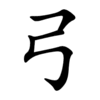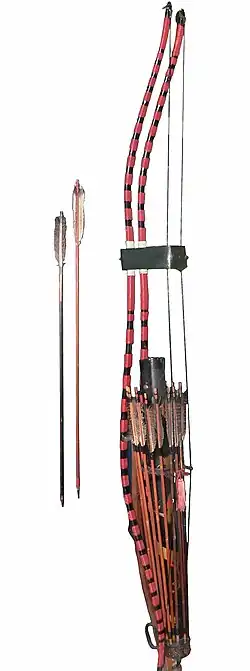弓
| ||||||||
| ||||||||
Translingual
| Stroke order | |||
|---|---|---|---|
 | |||
Han character
弓 (Kangxi radical 57, 弓+0, 3 strokes, cangjie input 弓 (N), four-corner 17207, composition ⿱コ㇉)
- Kangxi radical #57, ⼸.
Derived characters
References
- Kangxi Dictionary: page 356, character 1
- Dai Kanwa Jiten: character 9692
- Dae Jaweon: page 671, character 22
- Hanyu Da Zidian (first edition): volume 2, page 987, character 11
- Unihan data for U+5F13
Chinese
| simp. and trad. |
弓 | |
|---|---|---|
| alternative forms | 𭚥 | |
Glyph origin
| Historical forms of the character 弓 | |||||
|---|---|---|---|---|---|
| Shang | Western Zhou | Warring States | Shuowen Jiezi (compiled in Han) | Liushutong (compiled in Ming) | |
| Oracle bone script | Bronze inscriptions | Chu slip and silk script | Qin slip script | Small seal script | Transcribed ancient scripts |
 |
 |
 |
 |
 |
 |
Pictogram (象形) – a bow.
Etymology
Possibly related to Proto-Tibeto-Burman *kuːŋ (“tree, branch, stem”) (Coblin, 1986), semantically connected with the shape of a bent tree branch. Cognate with Burmese ကိုင်း (kuing:, “to bend over; to be bent”), အကိုင်း (a.kuing:, “stalk; branch”), Tedim Chin [script needed] (kung¹, “tree”), Jingpho kung (“to branch; to grow”), lakung (“branch; limb”), Lepcha ᰀᰩᰵ (kóng, “branch”), ᰀᰫᰵ (kúng, “tree”) (STEDT).
Schuessler (2007) proposes that both Old Chinese 弓 (OC *kʷɯŋ) and Proto-Tibeto-Burman *kuːŋ are derived from Proto-Mon-Khmer *koŋ, whence Nyah Kur [script needed] (kóoŋ, “bent (in the middle)”), Mon ကိုၚ် (“to be bent”), Khmer កោង (kaong, “to bend; to be bent”), Khasi pyrkhung (“to bend; to arch”), Pear kuŋ (“bend”), Vietnamese cong (“to be bent, curved”).
Also compare Proto-Tibeto-Burman *ku(ː)m (“arched; vaulted”)
Derivatives are 肱 (OC *kʷɯːŋ, “(upper) arm”) and 穹 (OC *kʰʷɯŋ, “arched; vault; sky”).
Pronunciation
Definitions
弓
Synonyms
- (bow of a stringed instrument, or a cotton bow, or catapult) 弓子 (gōngzi)
- (to arch): 彎曲/弯曲 (wānqū)
- (rainbow):
Compounds
- 一弓
- 主動脈弓/主动脉弓 (zhǔdòngmàigōng)
- 仲弓
- 傷弓之鳥/伤弓之鸟
- 半弓
- 天弓 (tiāngōng)
- 定弓田
- 定弓虛稅/定弓虚税
- 左右開弓/左右开弓
- 弓不虛發/弓不虚发
- 弓人 (gōngrén)
- 弓兒/弓儿
- 弓兒扯滿/弓儿扯满
- 弓兵
- 弓冶
- 弓匠
- 弓套
- 弓子 (gōngzi)
- 弓師/弓师
- 弓弓
- 弓弦 (gōngxián)
- 弓弩 (gōngnǔ)
- 弓形 (gōngxíng)
- 弓形鑽/弓形钻
- 弓影杯蛇
- 弓影浮杯
- 弓手 (gōngshǒu)
- 弓折矢盡/弓折矢尽
- 弓折箭盡/弓折箭尽
- 弓招
- 弓旌
- 弓根 (gōnggēn)
- 弓極/弓极
- 弓步 (gōngbù)
- 弓毛 (gōngmáo)
- 弓漿蟲/弓浆虫
- 弓琴
- 弓矛之士
- 弓矢 (gōngshǐ)
- 弓硯緣/弓砚缘
- 弓箭 (gōngjiàn)
- 弓箭手 (gōngjiànshǒu)
- 弓箭步 (gōngjiànbù)
- 弓繳/弓缴 (gōngzhuó)
- 弓背
- 弓腰
- 弓腰曲背
- 弓蕉 (gung1 ziu1)
- 弓蛇
- 弓裘
- 弓調馬服/弓调马服
- 弓足
- 弓身
- 弓鞋 (gōngxié)
- 弓鞬
- 弓韣/弓𱂋
- 弓馬/弓马 (gōngmǎ)
- 弓鰭魚/弓鳍鱼
- 弩弓
- 弸弓
- 張弓拔刃/张弓拔刃
- 張弓挾矢/张弓挟矢
- 強弓硬弩/强弓硬弩 (qiáng gōng yìng nǔ)
- 張弓簇箭/张弓簇箭
- 張羅彀弓/张罗彀弓
- 彈弓/弹弓 (dàngōng)
- 彎弓/弯弓
- 彎弓搭箭/弯弓搭箭
- 彤弓
- 彫弓/雕弓
- 悶弓兒/闷弓儿
- 手弓鋸/手弓锯
- 打背弓
- 扯弓搭箭 (chě gōng dā jiàn)
- 拈弓搭箭
- 拉硬弓
- 搭弩張弓/搭弩张弓
- 撥弓/拨弓
- 杯弓蛇影 (bēigōng-shéyǐng)
- 棄弓折箭/弃弓折箭
- 楚弓楚得
- 檀弓
- 櫜弓臥鼓/櫜弓卧鼓
- 步弓 (bùgōng)
- 滿弓/满弓
- 烹犬藏弓
- 玈弓
- 玉弓
- 琴弓 (qíngōng)
- 番弓
- 盤馬彎弓/盘马弯弓
- 硬弓
- 硬弩強弓/硬弩强弓
- 窄弓弓
- 窩弓/窝弓
- 綿弓/绵弓
- 繃弓/绷弓 (bēnggōng)
- 背弓
- 良弓
- 落背弓
- 角弓 (jiǎogōng)
- 調弓號猿/调弓号猿
- 貫弓/贯弓
- 開弓/开弓 (kāigōng)
- 開弦弓/开弦弓 (Kāixiángōng)
- 關弓/关弓
- 韜弓/韬弓
- 驚弓之鳥/惊弓之鸟 (jīnggōngzhīniǎo)
- 鳥盡弓藏/鸟尽弓藏 (niǎojìngōngcáng)
References
- “弓”, in 漢語多功能字庫 (Multi-function Chinese Character Database), 香港中文大學 (the Chinese University of Hong Kong), 2014–
Japanese
Readings
Etymology 1
| Kanji in this term |
|---|
| 弓 |
| ゆ Grade: 2 |
| kun’yomi |
From Old Japanese. In modern Japanese, only found as a prefix in compounds.[1][2]
Pronunciation
- IPA(key): [jɯ̟ᵝ]
Derived terms
Etymology 2



| Kanji in this term |
|---|
| 弓 |
| ゆみ Grade: 2 |
| kun’yomi |
From Old Japanese. Appears in the Man'yōshū (c. 759 CE). A surface analysis suggests a combination of Old Japanese yu (see above) + suffixing element mi, itself of uncertain derivation.
Noun
弓 • (yumi)
Coordinate terms
Derived terms
- 和弓 (wayumi, “Japanese bow/yumi”)
- 弓矢 (yumiya, “bow and arrow”)
- 大弓 (daikyū, “longbow”)
- 半弓 (hankyū, “shortbow”)
- 梓弓 (azusayumi, “a bow made from the wood of the Japanese cherry birch (Betula grossa”)
- 破魔弓 (hamayumi, “a traditional Shintō ceremonial bow for dispelling evil”)
- 重籐弓 (shigedōyumi), 滋籐弓 (shigedō yumi), 繁籐弓 (shigedō yumi, “a rattan wood bow”)
See also
- ロングボウ (rongubō, “longbow”)
Further reading
 弓_(武器) on the Japanese Wikipedia.Wikipedia ja (archery)
弓_(武器) on the Japanese Wikipedia.Wikipedia ja (archery) Yumi (Japanese archery bow) on Wikipedia.Wikipedia
Yumi (Japanese archery bow) on Wikipedia.Wikipedia  弓_(楽器) on the Japanese Wikipedia.Wikipedia ja (music)
弓_(楽器) on the Japanese Wikipedia.Wikipedia ja (music) Bow_(music) on Wikipedia.Wikipedia
Bow_(music) on Wikipedia.Wikipedia
Etymology 3
| Kanji in this term |
|---|
| 弓 |
| たらし Grade: 2 |
| kun’yomi |
Alteration from torashi, 連用形 (ren'yōkei, “stem or continuative form”) of verb torasu, from tora as the 未然形 (mizenkei, “incomplete form”) of verb 取る (toru, “to take”) + す (su, honorific suffix in Old Japanese). Original meaning was “something kept to hand”.[1][2]
Alternative forms
Pronunciation
- IPA(key): [ta̠ɾa̠ɕi]
Synonyms
- 御執, 御弓 (mitarashi)
Etymology 4
| Kanji in this term |
|---|
| 弓 |
| きゅう Grade: 2 |
| kan’on |
From Middle Chinese 弓 (MC kjuwng).[1][2] Compare modern Mandarin 弓 (gōng).
Noun
弓 • (kyū)
- (rare) a bow
- (obsolete) in ancient Chinese archery, a unit of length for measuring the distance between the archer and the target; one kyū was equal to six 尺 (shaku), roughly six feet or 182 centimeters
- (obsolete) in ancient China, a unit of length for surveying land; one kyū was equal to eight 尺 (shaku), roughly eight feet or 242 centimeters
Usage notes
In modern Japanese, the reading kyū is most often found in compounds.
Derived terms
References
- Shōgaku Tosho (1988) 国語大辞典(新装版) [Unabridged Dictionary of Japanese (Revised Edition)] (in Japanese), Tōkyō: Shogakukan, →ISBN
- Matsumura, Akira, editor (2006), 大辞林 [Daijirin] (in Japanese), Third edition, Tōkyō: Sanseidō, →ISBN
- NHK Broadcasting Culture Research Institute, editor (1998), NHK日本語発音アクセント辞典 [NHK Japanese Pronunciation Accent Dictionary] (in Japanese), Tōkyō: NHK Publishing, →ISBN
Korean

the shape of the Hun bow
Etymology
(This etymology is missing or incomplete. Please add to it, or discuss it at the Etymology scriptorium. Particularly: “Middle Korean readings, if any”)
Pronunciation
- (SK Standard/Seoul) IPA(key): [kuŋ]
- Phonetic hangul: [궁]
Vietnamese
Compounds
hình cung (形弓): an arc